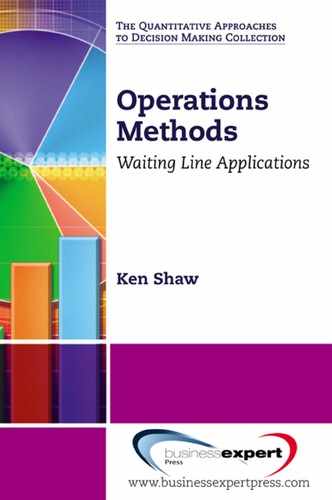You can find many useful queuing analysis references on the Internet, but many search listings containing the term queuing are likely to refer to communication network or software programming applications. Some useful references are listed here; using their titles in search engines as starting points are more likely to lead to the types of articles you are looking for.
Abilla, P. (2007). Psychology of queuing & Disneyland [Web log post]. Retrieved July 28, 2011 from http://www.shmula.com/psychology-of-queueing-disneyland/372
Bekker, R. (2005). Queues with state-dependent rates. Eindhoven, The Netherlands: Technische Universiteit Eindhoven. Retrieved July 30, 2011 from http://alexandria.tue.nl/extra2/200513578.pdf
Bozarth, C. C., & Handfield, R. B. (2008). Introduction to operations and supply chain management (2nd ed.). Upper Saddle River, NJ: Prentice Hall.
Chander, H. (2006). Contracts in outsourcing. Retrieved March 10, 2011, from http://www.math.vu.nl/en/Images/werkstuk-chander_tcm72-94371.doc
Easton, F. F. (2002). Labor requirements for multi-server multi-class finite queues. Retrieved March 10, 2011, from http://myweb.whitman.syr.edu/ffeaston/Research/Mmck_2cl.PDF
Fitzsimmons, J. A., & Fitzsimmons, M. J. (2011). Service management: Operations, strategy, information technology (7th ed.). New York, NY: McGraw-Hill.
Grasing, R. E. (2011). Branch performance by the new numbers. Retrieved July 24, 2011 from http://www.renolan.com/banking/article-branch_performance_by_the_new_numbers.htm
Haussmann, R. K. D. (1970). Waiting time as an index of quality of nursing care. Health Services Research, Summer, 92–105. Retrieved July 29, 2011, from http://www.ncbi.nlm.nih.gov/pmc/articles/PMC1067272/pdf/hsresearch00575-0014.pdf
Heizer, J., & Render, B. (2008). Operations management (9th ed.). Upper Saddle River, NJ: Prentice Hall.
Heyde, C. C., & Seneta, E. (Eds.). (2001). Statisticians of the centuries. New York, NY: Springer-Verlag.
Hillier, F. S., & Lieberman, G. J. (2010). Introduction to operations research (9th ed.). New York, NY: McGraw-Hill.
Jacobs, F. R., & Chase, R. B. (2011). Operations and supply chain management (13th ed.). New York, NY: McGraw-Hill.
Jardine, A. K. S., & Tsang, A. H. C. (2005). Maintenance, replacement, and reliability: Theory and applications. Boca Raton, FL: CRC Press.
Jelen, B. (2010). Microsoft 2010 Excel in depth. Indianapolis, IN: Que.
Khintchine, A. Y. (1932). Mathematical theory of a stationary queue. Matematicheskii Sbornik 39(4): 73–84.
Koenigsberg, E. (1960). Finite queues and cyclic queues. Operations Research, 8(2), 246–253.
Koerts, J. (1963). On mean waiting times and their reduction by priority procedures: An expository survey and some tables. Statistica Neerlandica, 17(3), 267–283. Retrieved from http://onlinelibrary.wiley.com/doi/10.1111/j.1467-9574.1963.tb01045.x/abstract
Kotha, S. K., Barnum, M. P., & Bowen, D. A. (1996). KeyCorp Service Excellence Management System. Interfaces 26(1), 54–74.
Krajewski, L. J., Ritzman, L. P., & Malhotra, M. K. (2010). Operations management: Processes and supply chains (9th ed.). Upper Saddle River, NJ: Prentice Hall.
Laguna, M., & Marklund, J. (2005). Business process modeling, simulation, and design. Upper Saddle River, NJ: Prentice-Hall.
Little, J. D. C. (1961). A proof of the queuing formula: L = λW. Operations Research, 9(3), 383–387.
Maister, D. H. (1985). The psychology of waiting lines. Retrieved July 28, 2011 from http://davidmaister.com/articles/5/52
Nelson, B. L. (2010). Stochastic modeling: Analysis & simulation. Mineola, NY: Dover.
Norman, D. A. (2008). The psychology of waiting lines. Retrieved July 28, 2011 from http://www.jnd.org/ms/Norman%20The%20Psychology%20of%20Waiting%20Lines.pdf
Oldrich, V. (1967). On the preemptive priority queues. Retrieved July 29, 2011, from http://www.kybernetika.cz/content/1967/2/147/paper.pdf
Peck, L. G., & Hazelwood, R. N. (1958). Finite queuing tables. In Publications in Operations Research (Vol. 2). New York, NY: John Wiley & Sons.
Pollaczek, F. (1930). Über eine aufgabe der wahrscheinlichkeitstheorie. Mathematische Zeitschrift 32: 64–100.
Shostack, G. L. (1984). Designing services that deliver. Harvard Business Review, 84115: 133–139. Retrieved July 27, 2011, from http://www.semanticfoundry.com/docs/servicesThatDeliver.pdf
Stevenson, W. J. (2011). Operations management (11th ed.). New York, NY: McGraw-Hill.
Sztrik, J. (2001). Finite-source queuing systems and their applications: A bibliography. Retrieved March 10, 2011, from http://irh.inf.unideb.hu/user/jsztrik/research/fsqreview.pdf
Vignaux, G. A. (2007). The bank: An example of a SimPy simulation. Retrieved March 10, 2011 from http://simpy.sourceforge.net/SimPyDocs/TheBank.html
Weida, N. C., Richardson, R., & Vazsonyi, A. (2001). Operations analysis using Microsoft Excel. Pacific Grove, CA: Duxbury–Thomson Learning.
Winston, W. L. (2004). Microsoft Excel data analysis and business modeling. Redmond, WA: Microsoft Press.
